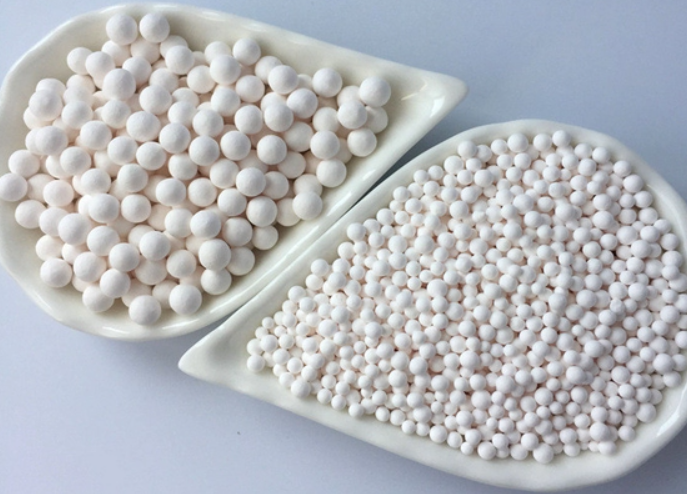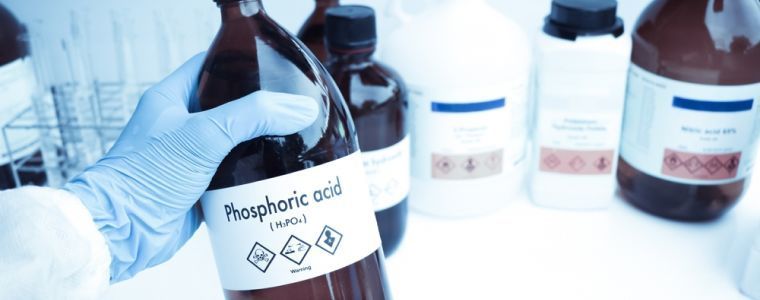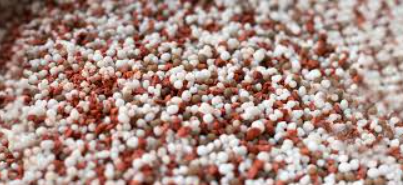Activated Alumina Balls – A Comprehensive Guide by Decachem
What Are Activated Alumina Balls?
Activated alumina balls are highly porous, solid spheres made from aluminum oxide (Al₂O₃). Engineered through a controlled thermal process, they are designed to offer exceptional surface area and adsorption capacity. Their unique structure makes them ideal for a variety of industrial applications, including drying gases and liquids, removing impurities and acting as catalysts or catalyst carriers.
The manufacturing process begins with the calcination of aluminum hydroxide at high temperatures, transforming it into an activated form of alumina. This is then shaped into uniform spherical balls and further treated to optimize porosity and mechanical strength.
Physically, activated alumina balls are white, odorless and non-toxic. Chemically inert, they resist thermal shock and can maintain structural integrity across a broad temperature range. Their high surface area (up to 350 m²/g) enables them to adsorb significant quantities of moisture or contaminants, making them highly efficient in desiccation and purification processes.
At Decachem, we focus on what matters - consistent quality, high purity and reliable performance. Nothing extra, just what you need.
Why Choose Activated Alumina Balls for Industrial Applications?
Activated alumina balls are a reliable choice for numerous industrial applications due to their outstanding adsorption performance and long-term durability. Their highly porous structure provides exceptional adsorption capacity, making them ideal for removing moisture, fluoride, sulfur compounds and other impurities from gas and liquid streams.
One of the key benefits of activated alumina is its ability to be regenerated. After reaching saturation, the material can be restored through thermal treatment, significantly extending its service life. This reusability not only reduces operational costs, but also supports more sustainable industrial practices.
Another crucial advantage is the high crush strength of the material. Activated alumina balls resist mechanical stress and pressure fluctuations, maintaining their shape and performance even in high-load systems. This makes them suitable for continuous use in harsh environments, such as gas drying units, petrochemical plants and water treatment facilities.
Their chemical inertness and thermal stability allow for seamless integration into a wide range of industrial processes without risk of contamination or degradation. Whether used as a desiccant, catalyst support, or adsorbent, they deliver consistent and dependable results.
Several Decachem clients in the natural gas and industrial air purification sectors have reported measurable efficiency improvements and extended media lifespans after switching to our premium-grade activated alumina. Explore real-world results or contact us for technical documentation.
Key Applications of Activated Alumina Balls
Water Treatment and Fluoride Removal
Activated alumina balls are extensively used in municipal and industrial water treatment systems for the adsorption of fluoride, arsenic and other contaminants. Due to their high surface area and selectivity, they efficiently remove impurities without introducing new chemical risks, making them safe for drinking water applications. Decachem supplies alumina balls tailored for high-performance water purification, ensuring reliable and long-lasting results.
Air and Gas Drying Systems
In compressed air and gas drying systems, activated alumina serves as a highly effective desiccant. Whether used in instrument air dryers, heatless or heat-regenerative air dryers, or desiccant towers, Alumina balls provided by Decachem are consistent moisture control and superior adsorption efficiency – even under fluctuating pressure and temperature conditions.
Petrochemical and Refinery Use
Activated alumina is also used in petrochemical plants and refineries for the removal of acid gases, hydrocarbons and sulfur compounds. In sulfur recovery units, alumina balls provided by Decachem help enhance reaction efficiency and reduce downtime by maintaining structural integrity and adsorption power under extreme conditions.

Alumina Balls by Decachem – What Sets Us Apart
We offer custom sizing and packaging options to meet your exact process requirements, minimizing waste and maximizing efficiency. Decachem also ensures a reliable supply chain supported by expert technical guidance – before and after your purchase.
Every product from Decachem comes with comprehensive documentation, with a reputation built on precision and trust, Decachem is your partner for reliable alumina solutions worldwide.
How to Choose the Right Alumina Balls for Your Needs
Selecting the right activated alumina balls is essential for maximizing performance and extending the life of your system. Several key factors should guide your decision.
Particle size plays a critical role in system efficiency. Smaller particles offer higher surface area and faster adsorption rates, but may cause increased pressure drop. Larger particles, on the other hand, provide better flow characteristics and are ideal for high-volume or high-pressure systems.
Moisture load is another important consideration. For high-humidity environments or gas streams with significant water content, a higher-capacity alumina grade may be necessary to ensure consistent drying without early saturation.
Operating temperature must also be factored in. Activated alumina performs optimally within a specific thermal range; exceeding it can lead to degradation or reduced adsorption efficiency.
Common mistakes to avoid include choosing incorrect particle sizes, overlooking regeneration compatibility, or mismatching product specs with process conditions. These issues can lead to increased maintenance costs and reduced performance.
How to Regenerate and Maintain Activated Alumina Balls
Proper regeneration and maintenance of activated alumina balls are key to maximizing their lifespan and performance. Over time, the adsorbent becomes saturated with moisture or contaminants and must be regenerated to restore its adsorption capacity.
Regeneration typically involves heating the alumina balls to a temperature range of 150°C to 300°C (302°F to 572°F) in a controlled airflow. The specific temperature and duration depend on the level and type of saturation. Thermal regeneration is most effective for moisture-laden media, while chemical flushing may be required for specific contaminants.
Replacement is recommended when regeneration no longer restores the original adsorption efficiency – usually after several cycles or when mechanical breakdown (dusting or fragmentation) becomes apparent.
Storage is just as important. Keep activated alumina balls in a dry, airtight container or sealed packaging to prevent premature moisture absorption. Avoid exposure to open air or humid environments prior to use.
Frequently Asked Questions (FAQs)
Can activated alumina be reused?
Yes. Activated alumina can be regenerated and reused multiple times, depending on the application and maintenance.
Is it safe for drinking water applications?
Absolutely. Food-grade and water-grade activated alumina is non-toxic and widely used for fluoride and arsenic removal in municipal water treatment.
How does it compare to silica gel or molecular sieves?
Activated alumina offers higher crush strength and broader chemical resistance than silica gel, while being more cost-effective than molecular sieves in many applications.
What is the lifespan under typical use?
With proper regeneration and handling, alumina balls can last 1–3 years, depending on operating conditions.
Why Partner with Decachem for Your Alumina Needs
With lots of experience in industrial chemical solutions, Decachem is your trusted partner for high-performance activated alumina balls. Our team of dedicated technical experts is available to offer tailored advice and support, ensuring optimal solutions for your specific requirements.
We provide global distribution and logistics, guaranteeing timely delivery and reliable service no matter where you’re located. When you choose Decachem, you’re choosing quality, efficiency and ongoing support.
Contact us for a free consultation or quote and let us help you find the perfect alumina solution for your needs.
















